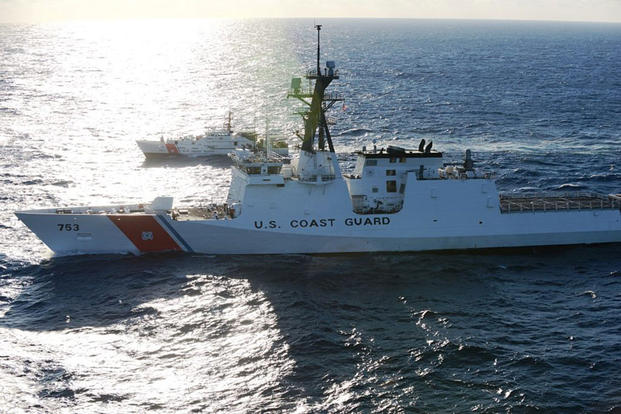As the Navy searches for the best design for its future frigate, some are promoting an option based on the Coast Guard's national security cutter.
And while Coast Guard Commandant Adm. Paul Zukunft isn't directly weighing in on the discussion, he has plenty to say about the ship in question.
At an event this week organized by the U.S. Naval Institute and held at the Center for Strategic and International Studies in Washington, D.C., Zukunft recounted a "sea story" that he has often retold in public: How the new Coast Guard cutter Hamilton, on its 2016 maiden deployment, more than paid for itself with a remarkable 13 major drug interdictions that resulted in the confiscation of a total of nearly $1 billion worth of cocaine.
On the same deployment, the Hamilton conducted medical evacuations from Haiti in the wake of Hurricane Matthew and intercepted hundreds of migrants attempting to enter the U.S. illegally from Cuba.
Related content:
- McCain Blasts Navy Warships in Report on Pentagon Waste
- New World Threats Prompt Navy to Review Frigate Design
- Military.com's Equipment Guide: National Security Cutter
"This is a ship that will be in service 30, 40 years from now," Zukunft said. "So I would say that's a pretty good return on investment. There were no hiccups. We didn't have to tow her back in. It was a great maiden voyage."
Nearly a decade after the commissioning of the Navy's first littoral combat ship in 2008, the class has continued to face criticism over its survivability and design.
Last year, the Navy ordered major changes to engineer training and the LCS deployment strategy after four of the then-six ships in service suffered significant engineering casualties within 12 months of each other.
The Navy had been set to base its future frigate on the LCS design but, in early July, announced that it would reopen analysis, putting out a request to industry for possible frigate designs.
A Navy spokesman, Lt. Seth Clarke, said the decision was a result of changes to the operational environment.
"We have witnessed increasing competition for sea control, an increasingly complex operating environment, and an emphasis on Distributed Maritime Operations," he told Military.com in a statement.
If the service pursues a design based on the national security cutter -- a proposal being put forward by shipbuilder Huntington Ingalls Industries -- the concept will have to be significantly reworked in order to accommodate weapons and defenses for high-end naval warfare.
But that "can certainly be done," Zukunft said.
"Many of the systems on there right now are Navy-type, Navy-owned," he said. "It's one of these national security cutters that is the flagship for the surface action group for the [biennial] Rim of the Pacific exercise. So we're used to interoperability with the Navy as well."
To date, however, no formal conversations have taken place between the Coast Guard and Navy about the design, Zukunft said.
The Navy is looking to award a contract for design and construction in fiscal 2020.










